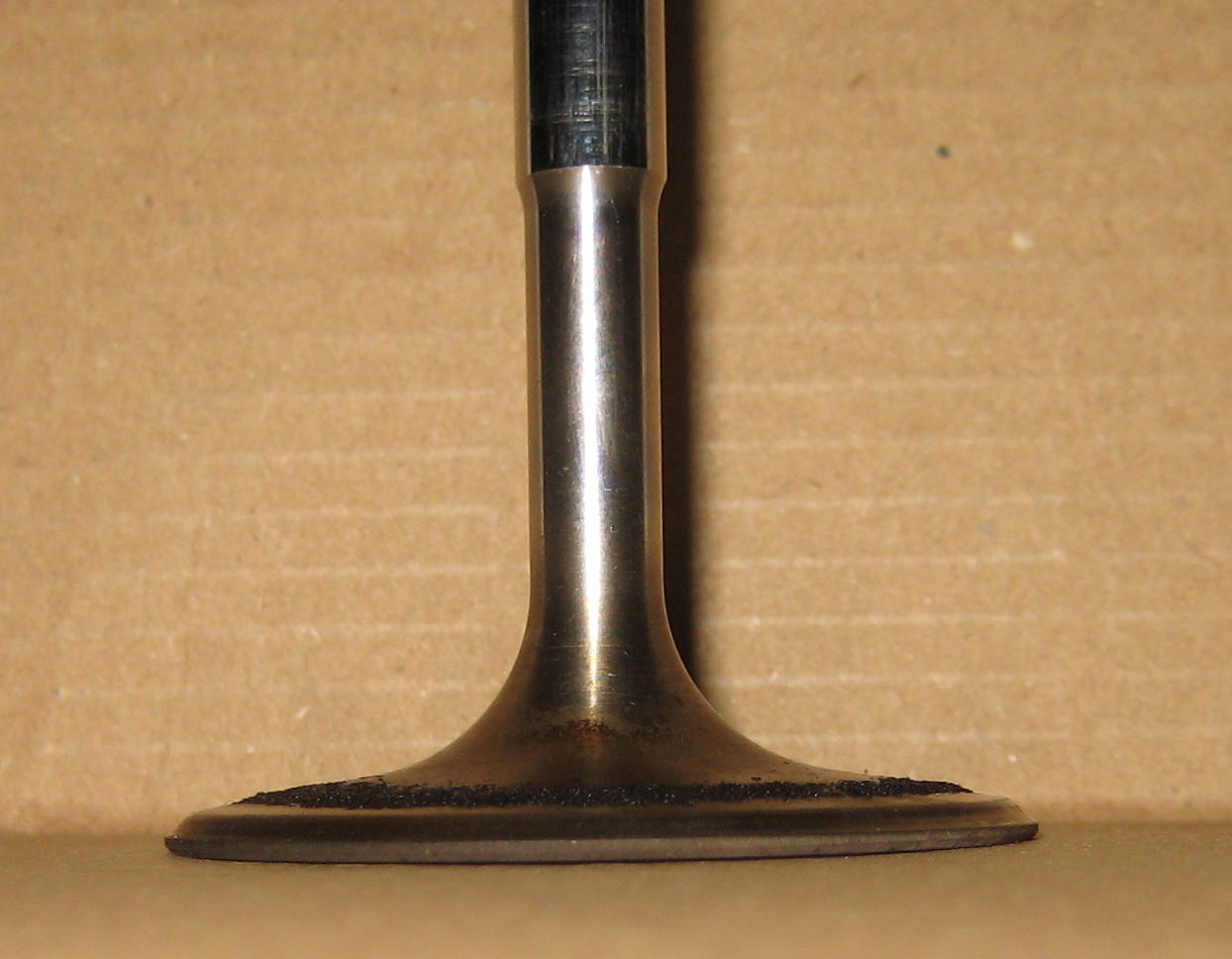Valve Guide Loose in Head - Options?
Discussion
Mignon said:
At least we have a meaty technical topic to get stuck into for a change. Hopefully someone else's engine will blow up in an interesting way soon.
I'm not volunteering.The stock engine (Mitsubishi 4G64) in my van needed the head welding last year after a HG leak (blowby into a cooling passage) caused some erosion.
As it had only done 360,000 km in it's 25 year life, and only some of that was towing a tandem car trailer at 100kph in 40+ degrees, I was very disappointed with the engineers who designed it.
Lol, I was thinking the same.
My money wouldn't be on the guide suffering det damage in this instance, the guide is too far away from the source and I don't think the heat could have travelled up an inlet valve like that.
What I would like to know or discuss is the detonation. It's a very difficult thing to understand when you look really deep into it. We can all say yeah that's det damage, but it's very much like lightening. You have different types and it strikes at different areas too, probably as it has different causes.
Specifically in this case the damage done to the squish pads ties in with another one I saw where it was caused by oil in the combustion chamber, this was also 2vpc and wrecked the squish pads in a similar way, it was like the surface of a hedgehog and was never run again, i've still got it somewhere.
My money wouldn't be on the guide suffering det damage in this instance, the guide is too far away from the source and I don't think the heat could have travelled up an inlet valve like that.
What I would like to know or discuss is the detonation. It's a very difficult thing to understand when you look really deep into it. We can all say yeah that's det damage, but it's very much like lightening. You have different types and it strikes at different areas too, probably as it has different causes.
Specifically in this case the damage done to the squish pads ties in with another one I saw where it was caused by oil in the combustion chamber, this was also 2vpc and wrecked the squish pads in a similar way, it was like the surface of a hedgehog and was never run again, i've still got it somewhere.
227bhp said:
Lol, I was thinking the same.
Specifically in this case the damage done to the squish pads ties in with another one I saw where it was caused by oil in the combustion chamber, this was also 2vpc and wrecked the squish pads in a similar way, it was like the surface of a hedgehog and was never run again, i've still got it somewhere.
I'll second that especially seeing the spark plug.Specifically in this case the damage done to the squish pads ties in with another one I saw where it was caused by oil in the combustion chamber, this was also 2vpc and wrecked the squish pads in a similar way, it was like the surface of a hedgehog and was never run again, i've still got it somewhere.
If it was down the guide I presume the op would have said to look at the oily snail trail around the guide and back of the valve?
Peter
PeterBurgess said:
I'll second that especially seeing the spark plug.
If it was down the guide I presume the op would have said to look at the oily snail trail around the guide and back of the valve?
Peter
Given the amount of clearance around the guide, there must have been a fair amount of oil dribbling past it.If it was down the guide I presume the op would have said to look at the oily snail trail around the guide and back of the valve?
Peter
OP, did it show any smoke at idle?
I measured several of the intake valves
They are all 120.50mm, if they had stretched I would expect them all to be slightly different
But they weren't, not to within the accuracy that I can measure with my Verniers
These show that the flat face of the intake valve does distort (they are definitely not dished by design)
I simply tried cleaning the face with some wet & dry on a flat surface
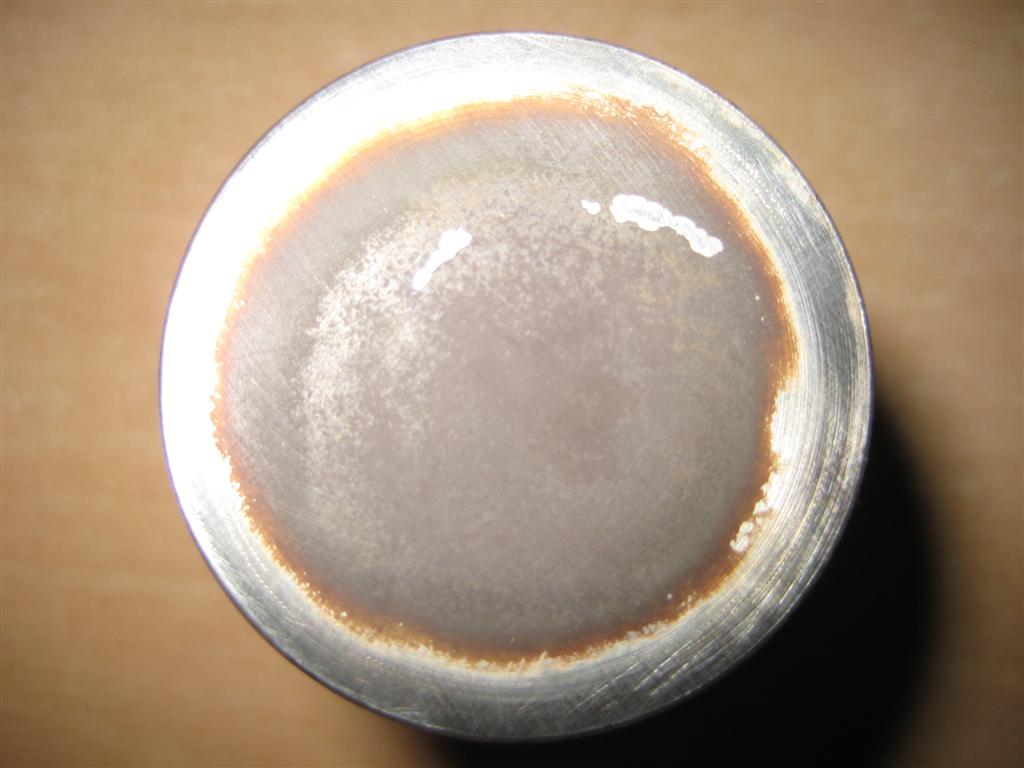
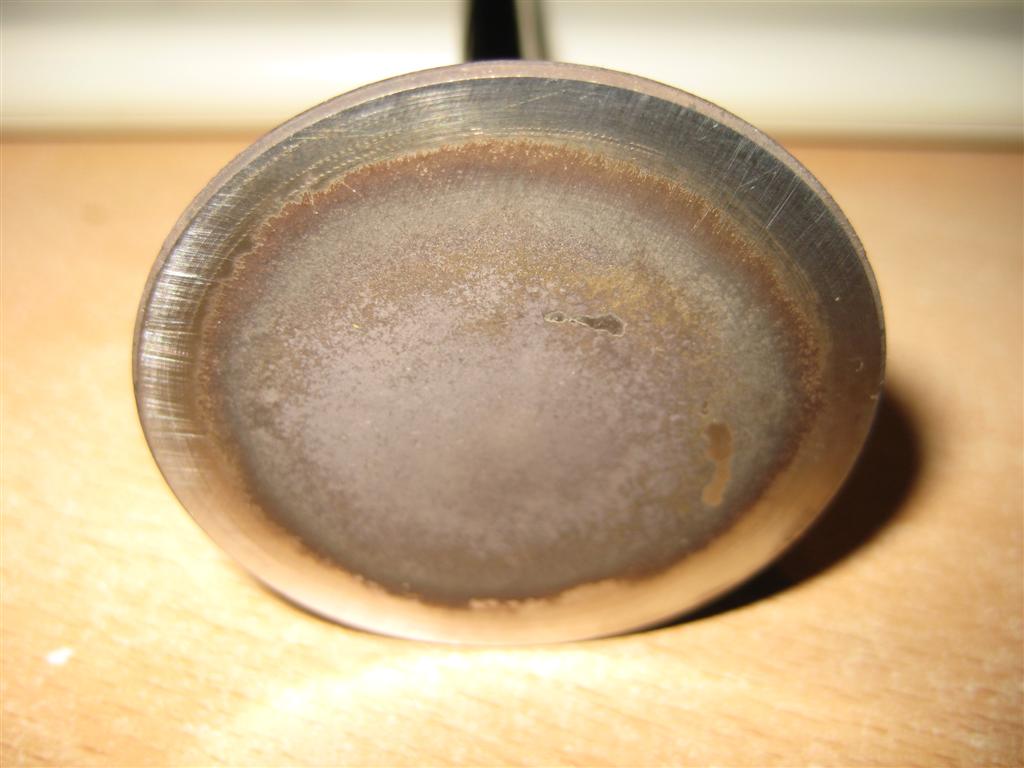
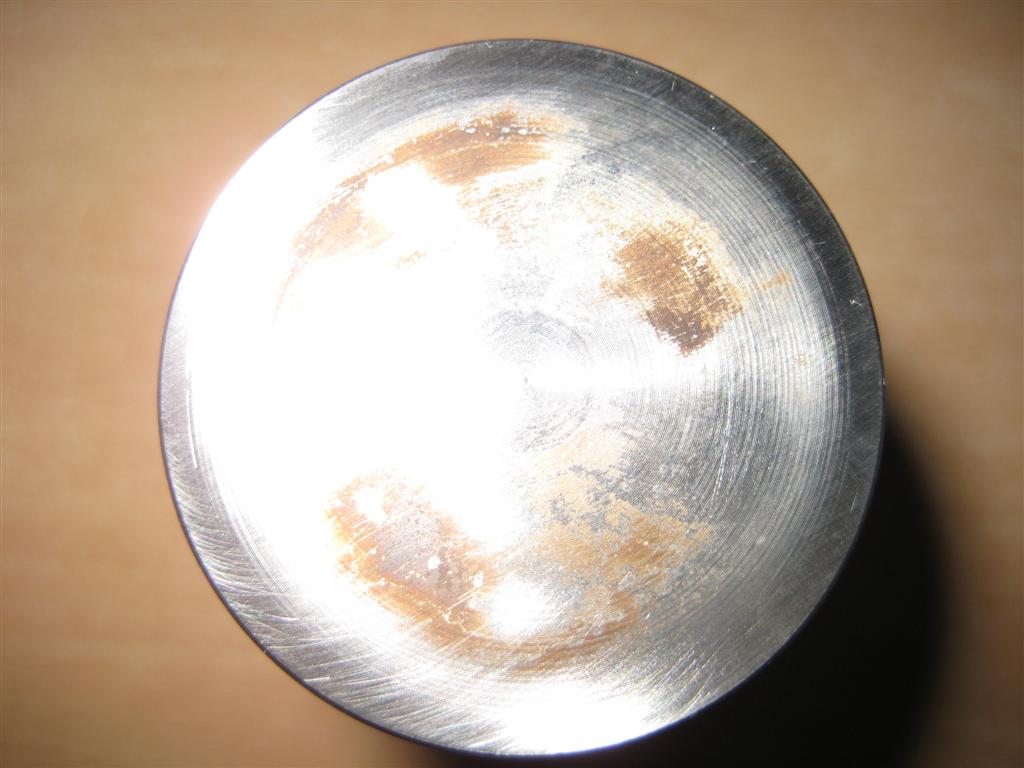
These are the pair of valves from the damaged cylinder
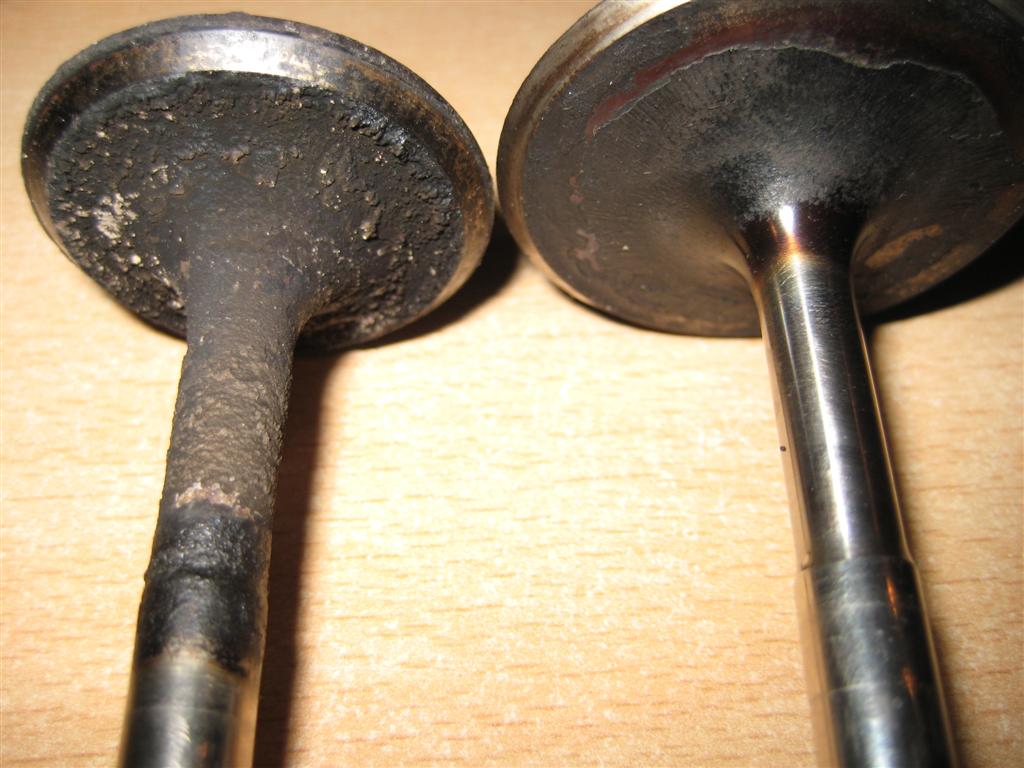
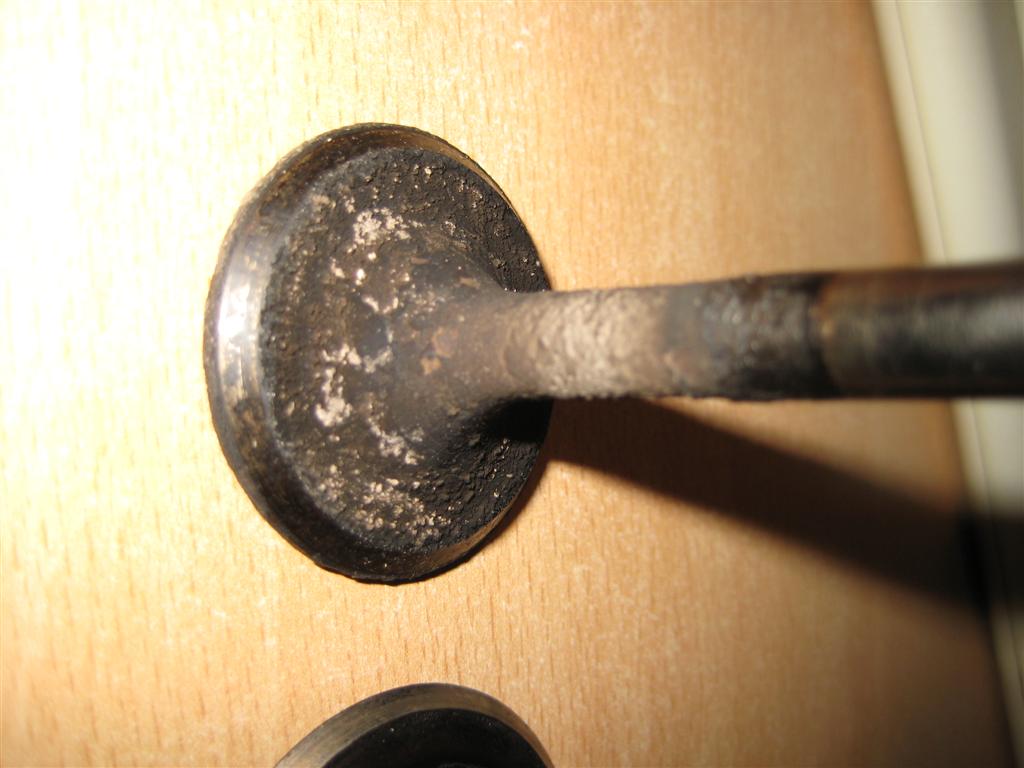
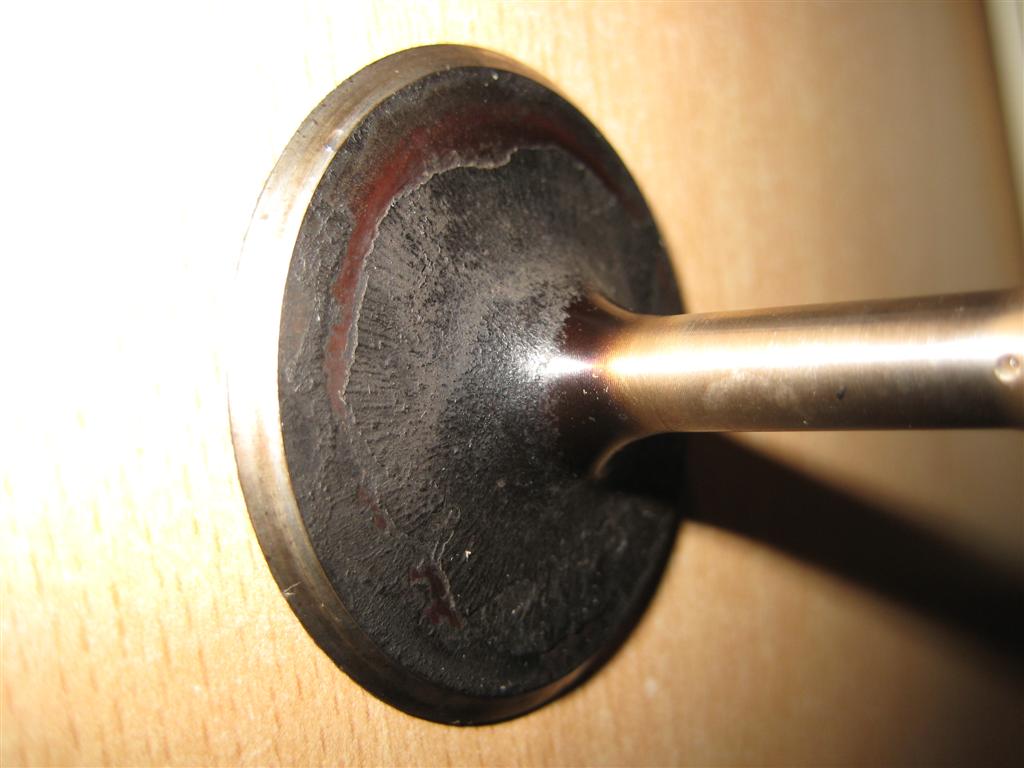
They are all 120.50mm, if they had stretched I would expect them all to be slightly different
But they weren't, not to within the accuracy that I can measure with my Verniers
These show that the flat face of the intake valve does distort (they are definitely not dished by design)
I simply tried cleaning the face with some wet & dry on a flat surface



These are the pair of valves from the damaged cylinder



Edited by ukkid35 on Friday 16th March 18:49
Hopefully these photos will help with the timeline
First time immediately after purchase, no sign of damage (other than corrosion)
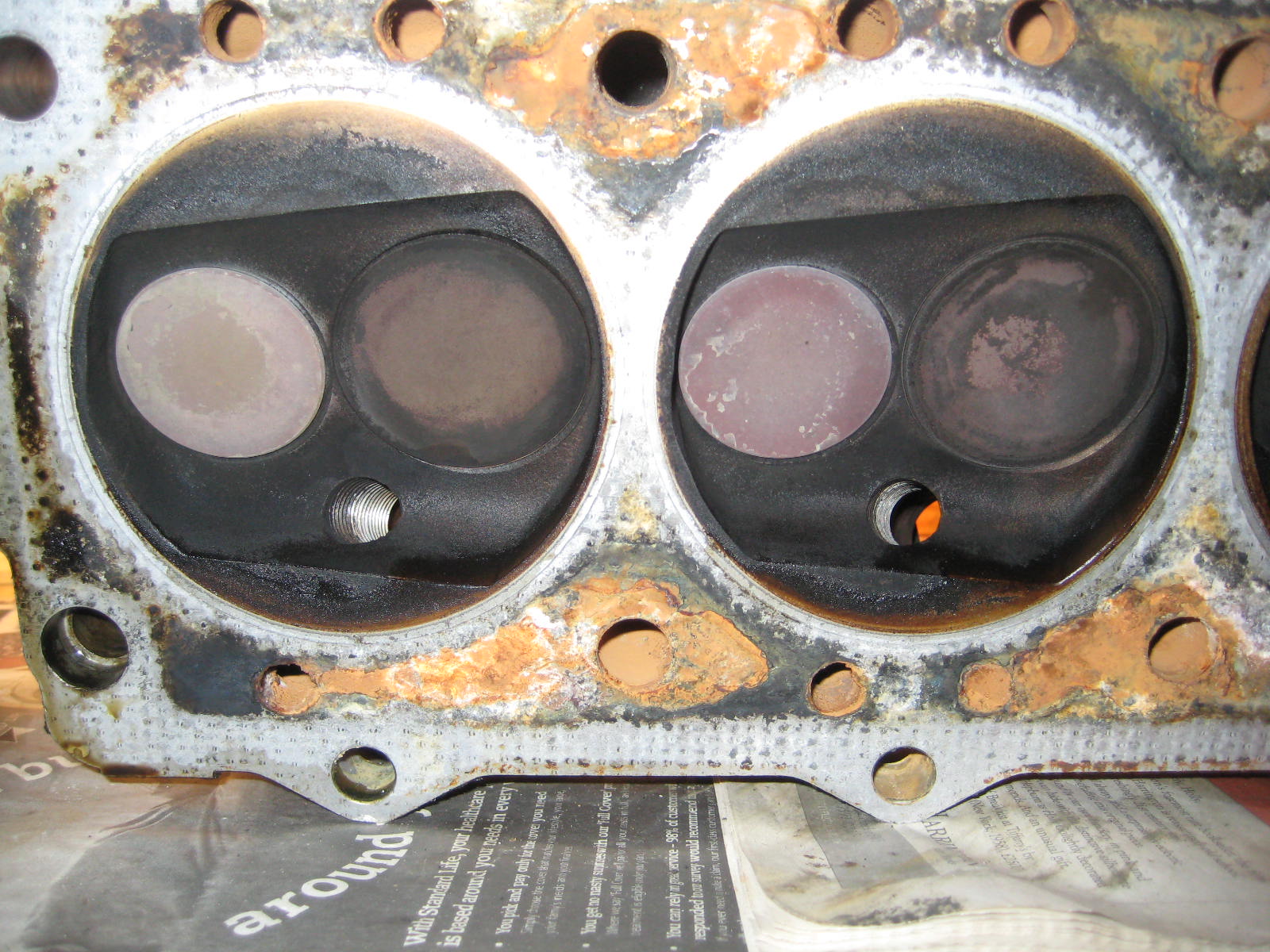
Sadly I only have a photo of the other head after the head skim
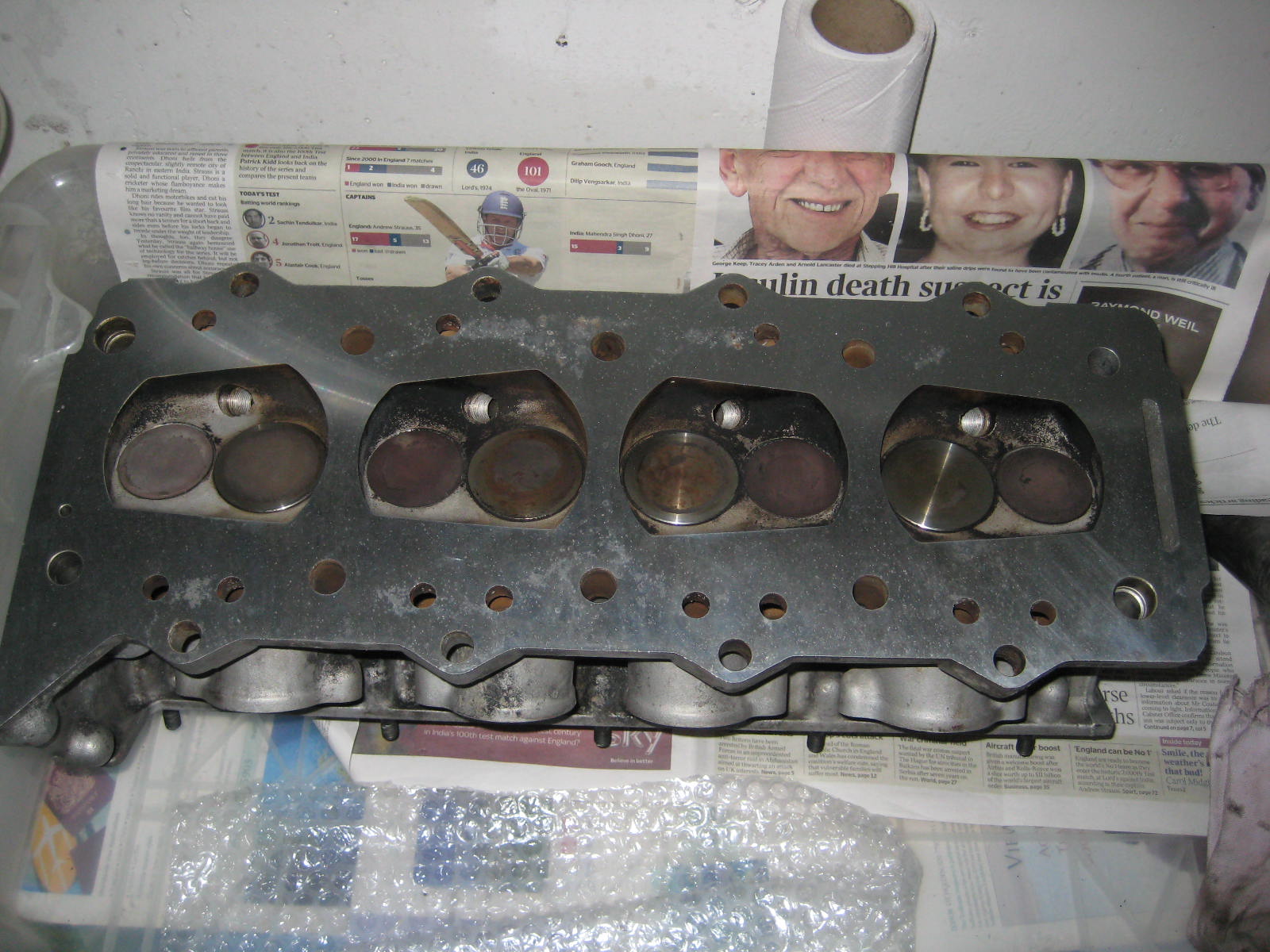
Second time after about 15k miles, obvious signs of pitting in the combustion chamber
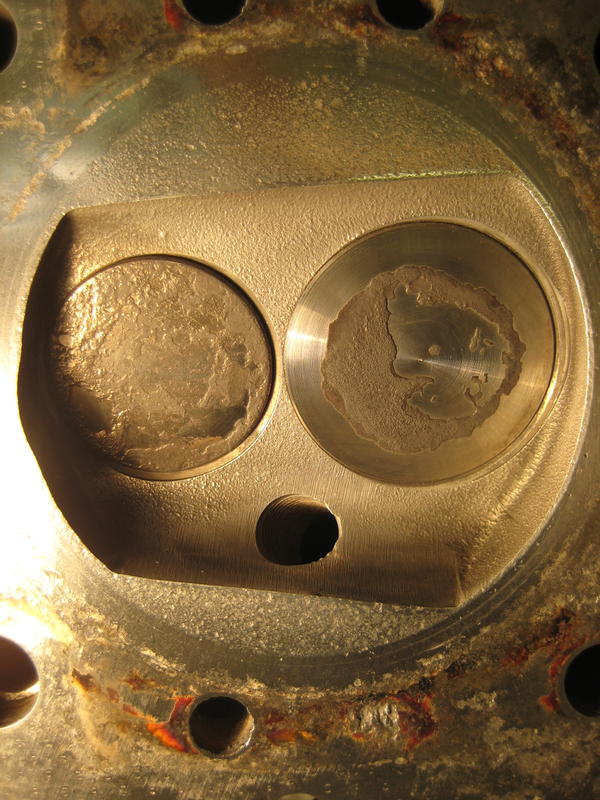
After the head skim
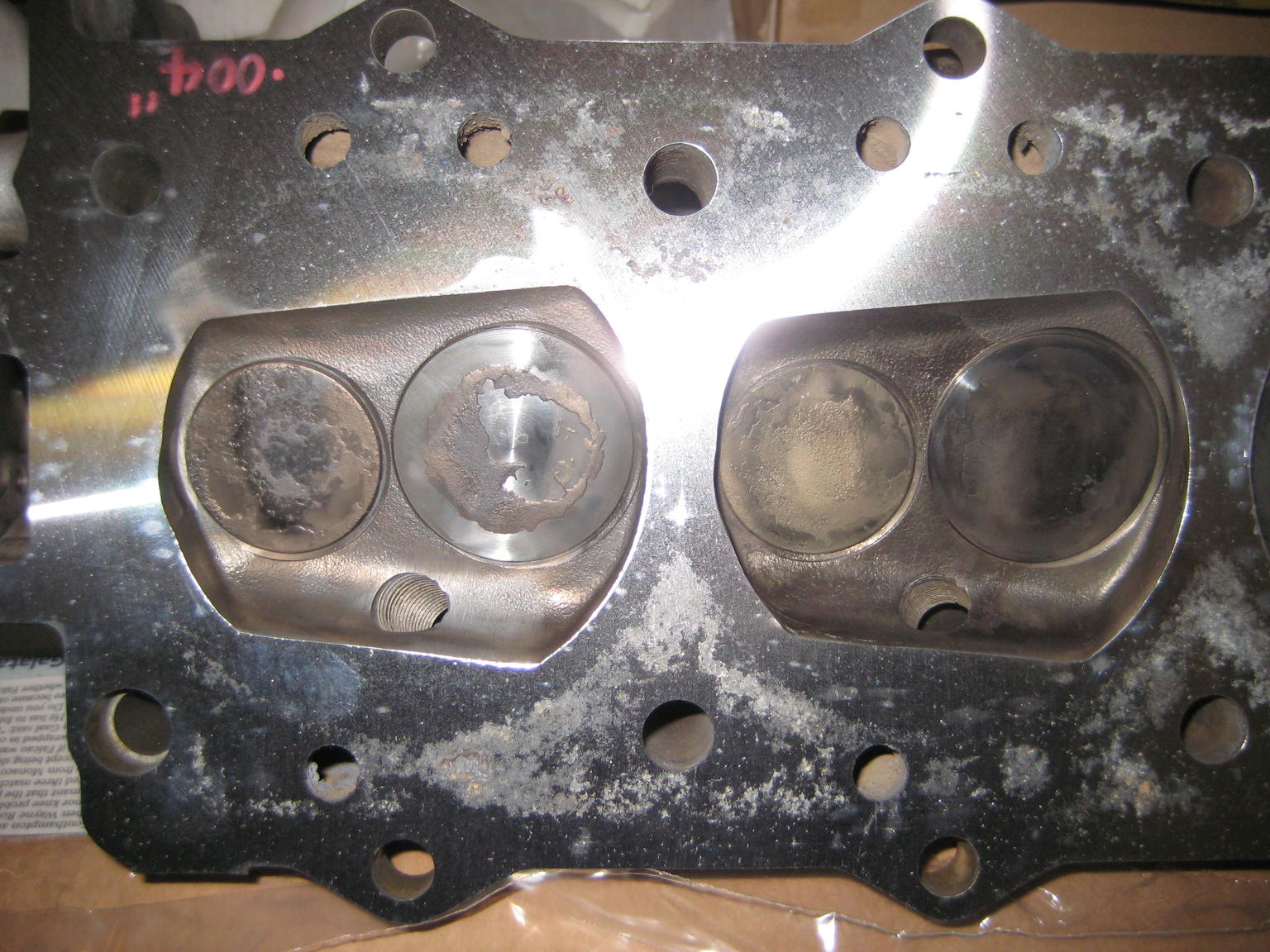
Close up of area showing that some pitting remains after the head skim
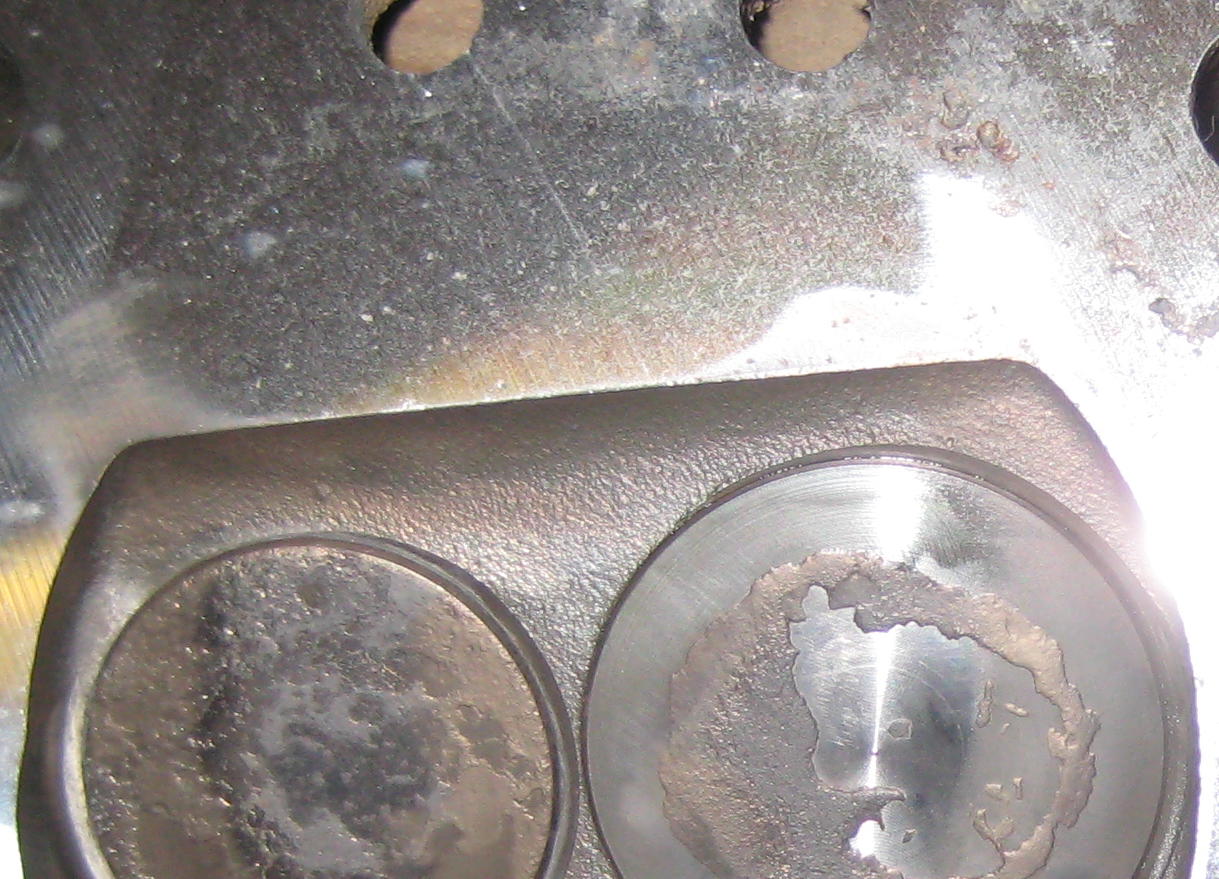
Faulty injector now discovered and replaced
Third time after another 10k or so, difficult to say whether there is additional pitting
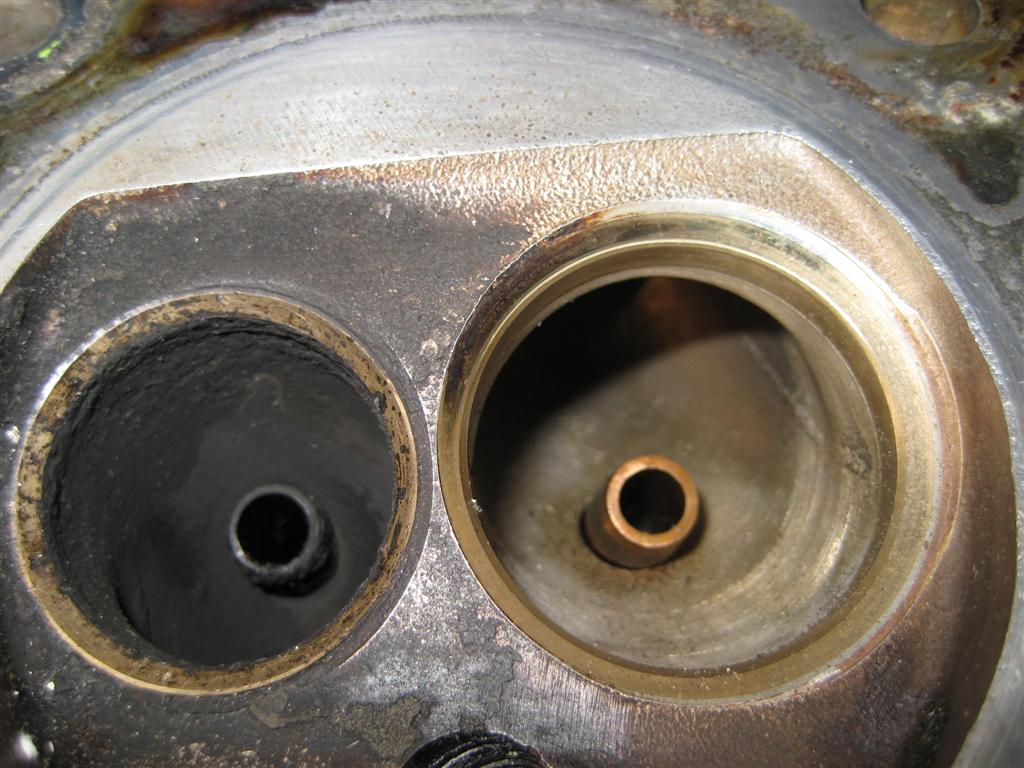
First time immediately after purchase, no sign of damage (other than corrosion)

Sadly I only have a photo of the other head after the head skim

Second time after about 15k miles, obvious signs of pitting in the combustion chamber

After the head skim

Close up of area showing that some pitting remains after the head skim

Faulty injector now discovered and replaced
Third time after another 10k or so, difficult to say whether there is additional pitting

Edited by ukkid35 on Friday 16th March 20:13
ukkid35 said:
These show that the flat face of the intake valve does distort (they are definitely not dished by design)
They should be dished. It saves weight and it improves the distribution of stresses in the valve head as it heats up and cools down. As I mentioned previously the online photos I found of your inlet valves shows they have insufficient land depth. The land is the bit of vertical between the valve face and the start of the 45 degree seat. It provides the strength for the seat area and prevents this distorting and pulling down away from the stem under the hammering action against the seat insert in the chamber. On a valve of that size the land depth should be 1.25mm but yours have very little if any. A photo sideways on would be nice but from the ones you have provided it looks like the seat almost ends in a knife edge against the valve face. Very bad design. If I was reconditioning a race engine and the valves had got to that stage they'd be binned rather than refaced and put back into the head. Yours apparently come shagged out as new.AW111 said:
Given the amount of clearance around the guide, there must have been a fair amount of oil dribbling past it.
OP, did it show any smoke at idle?
No smoke at idle or on under engine brakingOP, did it show any smoke at idle?
The engine does use oil when on track, no so much on road, I presumed this was due to blow by
There's no valve in the crankcase ventilation, and this links to the airbox directly next to the damaged cylinders air intake
Like PB says, we need a sideways view of the inlet valve to see the thickness of that vital portion of the valve. Maybe a measurement too although you'll need good eyesight and measuring tools to get it accurately. The facts it's had an angle ground from the face to encourage better gasflow is misleading to the eye at the moment. What is the valve diameter?
I'd agree that initially it looks like the valve is too thin therefore weak in that area and is being 'cupped'. Maybe it does this on its own, but what will accelerate it is strong valve springs and also worn (or loose!) guides as when the valve comes to a close it doesn't hit the seat square on so beats it all the way round bit by bit.
I very much doubt the valves were like that from new, you either have a prominent worthy dish or flat face, the fact you've managed to sand most of it away shows it and how slight it is.
How would you prevent it? Good valve to guide clearance, materials and possibly specially made valves if that is the issue. Maybe even do some research on the strength of the springs. You could also fit new valve seats and make them use a different portion of the valve seat, but you would lose a little flow as the throat would be smaller.
I'd agree that initially it looks like the valve is too thin therefore weak in that area and is being 'cupped'. Maybe it does this on its own, but what will accelerate it is strong valve springs and also worn (or loose!) guides as when the valve comes to a close it doesn't hit the seat square on so beats it all the way round bit by bit.
I very much doubt the valves were like that from new, you either have a prominent worthy dish or flat face, the fact you've managed to sand most of it away shows it and how slight it is.
How would you prevent it? Good valve to guide clearance, materials and possibly specially made valves if that is the issue. Maybe even do some research on the strength of the springs. You could also fit new valve seats and make them use a different portion of the valve seat, but you would lose a little flow as the throat would be smaller.
A tantalising pic that almost, but not quite, may or may not show mushrooming of the transition from seat to fireface.
It would have been nice to see the head and valves 'in the flesh'.
I get the feeling these engines, as they are such high revvers, need overhauling frequently to avoid problems.
Peter
It would have been nice to see the head and valves 'in the flesh'.
I get the feeling these engines, as they are such high revvers, need overhauling frequently to avoid problems.
Peter
PeterBurgess said:
A tantalising pic that almost, but not quite, may or may not show mushrooming of the transition from seat to fireface.
It would have been nice to see the head and valves 'in the flesh'.
I get the feeling these engines, as they are such high revvers,need overhauling frequently should have used better materials in the first place to avoid problems.
Peter
It would have been nice to see the head and valves 'in the flesh'.
I get the feeling these engines, as they are such high revvers,
Peter
The land is not quite as thin as I had surmised but it is a tad on the narrow side and not helped by being chamfered which is bad for reverse flow during the valve overlap period. Exhaust valves should be chamfered or radiused and inlet ones should be sharp edged. Including the chamfer it's probably not far off the 1.25mm I suggested. I suspect the stem wear is down to not being chrome plated. Chrome is essential with iron guides but only optional with bronze ones but for just a few pence per valve it markedly improves wear resistance and stem life. Pointless cost cutting by TVR no doubt. Chrome is many times harder than the base valve steel and also reduces sliding friction.
PeterBurgess said:
A tantalising pic that almost, but not quite, may or may not show mushrooming of the transition from seat to fireface.
It would have been nice to see the head and valves 'in the flesh'.
I get the feeling these engines, as they are such high revvers, need overhauling frequently to avoid problems.
Peter
Did he not say they only rev to a little over 7k ?It would have been nice to see the head and valves 'in the flesh'.
I get the feeling these engines, as they are such high revvers, need overhauling frequently to avoid problems.
Peter
7000 is a lot of revs for an engine with those stonking big valves, one could see rapid wear and once worn poor sealing leading to even more rapid wear, maybe 10000 miles? Our race Bs do 30 hours before we rebuild them and are beginning to show some wear although not drastically. 30 hours at 100 mph for example is 3000 track miles. Does anyone have any record for race use AJP8 engines of hours between builds? What sort of mileage do owners get with 'normal' road use?
Peter
Peter
PeterBurgess said:
Does anyone have any record for race use AJP8 engines of hours between builds? What sort of mileage do owners get with 'normal' road use?
Peter
I don't have any figures, but the AJP8 was used extensively in dry sump form as the engine used in the Tuscan Challenge race series from about 1990. The Cerb was introduced in 1996 with a wet sump versionPeter
I know of a couple of cars that have covered about 100k without any serious engine work
Mine has managed about 60k so far about half of that in my hands
I think the fuel cut is at 7700, and the warning buzzer comes on at about 7200, which is also roughly peak power
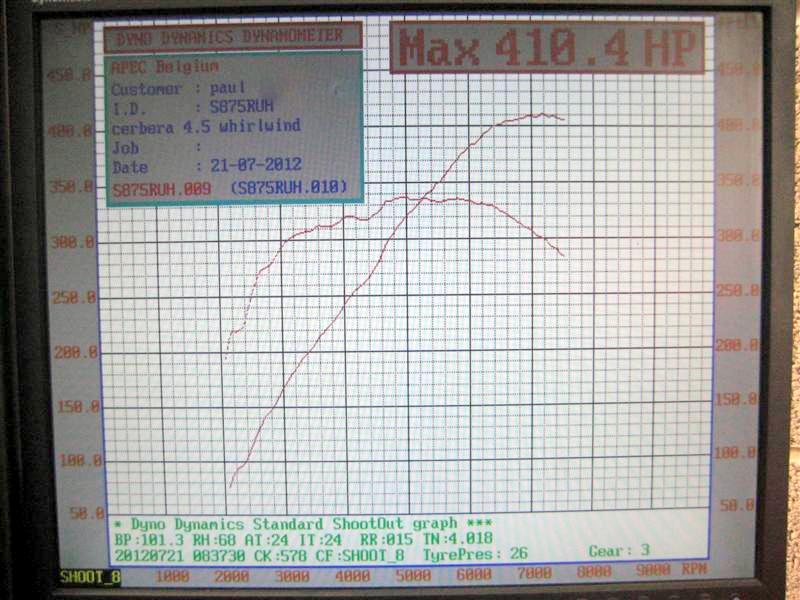
PeterBurgess said:
7000 is a lot of revs for an engine with those stonking big valves, one could see rapid wear and once worn poor sealing leading to even more rapid wear, maybe 10000 miles? Our race Bs do 30 hours before we rebuild them and are beginning to show some wear although not drastically. 30 hours at 100 mph for example is 3000 track miles. Does anyone have any record for race use AJP8 engines of hours between builds? What sort of mileage do owners get with 'normal' road use?
Peter
They're baby valves ! lol. Even my LS which still has relatively small valves compared to some are 52.0mm 7k not a problemPeter
How many miles have you done hard use prolonged 7K one build? At 30 hours our B valves 34.3mm ex and 43/45mm inlet ( depending on spec) will lap in but we prefer a light reface. The CI seat in the head for the inlet benefits from a tickle, the leadfree ex seat insert doesn't need recut. No visible wear on stems whether chrome/tuftride or plasma nitride treated.
Peter
Peter
Gassing Station | Engines & Drivetrain | Top of Page | What's New | My Stuff




